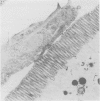Abstract
The human enteric protozoan, Giardia lamblia, has surface membrane lectin activity which mediates parasite adherence to erythrocytes. To determine whether an intestinal binding site exists for this lectin we have studied the interaction in vitro between axenically cultured Giardia trophozoites and isolated rat intestinal epithelial cells. Scanning electron microscopy showed that Giardia attached to the apical microvillus membrane and basolateral membrane of rat enterocytes. Any location on the parasite surface could mediate attachment without predeliction for the ventral disc. Trophozoites attached more avidly to jejunal compared with colonic epithelial cells. Attachment was inhibited at 4 degrees C, by sugars and glycoproteins containing D-mannosyl residues and by subagglutinating concentrations of anti-Giardia rabbit serum and two monoclonal antibodies, all with reactivity to parasite surface membrane determinants. Trypsinisation of trophozoites also reduced attachment but the ability to attach was rapidly restored after returning trophozoites to TYI-S culture medium for 4 h at 37 degrees C. Attachment was unaltered by the presence of the microfilament inhibitor cytochalasin B and in the absence of Ca++ and Mg++ ions. These findings support previous work that Giardia possesses a surface membrane mannose binding lectin and indicate that appropriate binding sites are present on rat intestinal epithelial cells. This lectin may play a part in mediating adherence of Giardia to mammalian intestine and could be a target for host immune defence.
Full text
PDF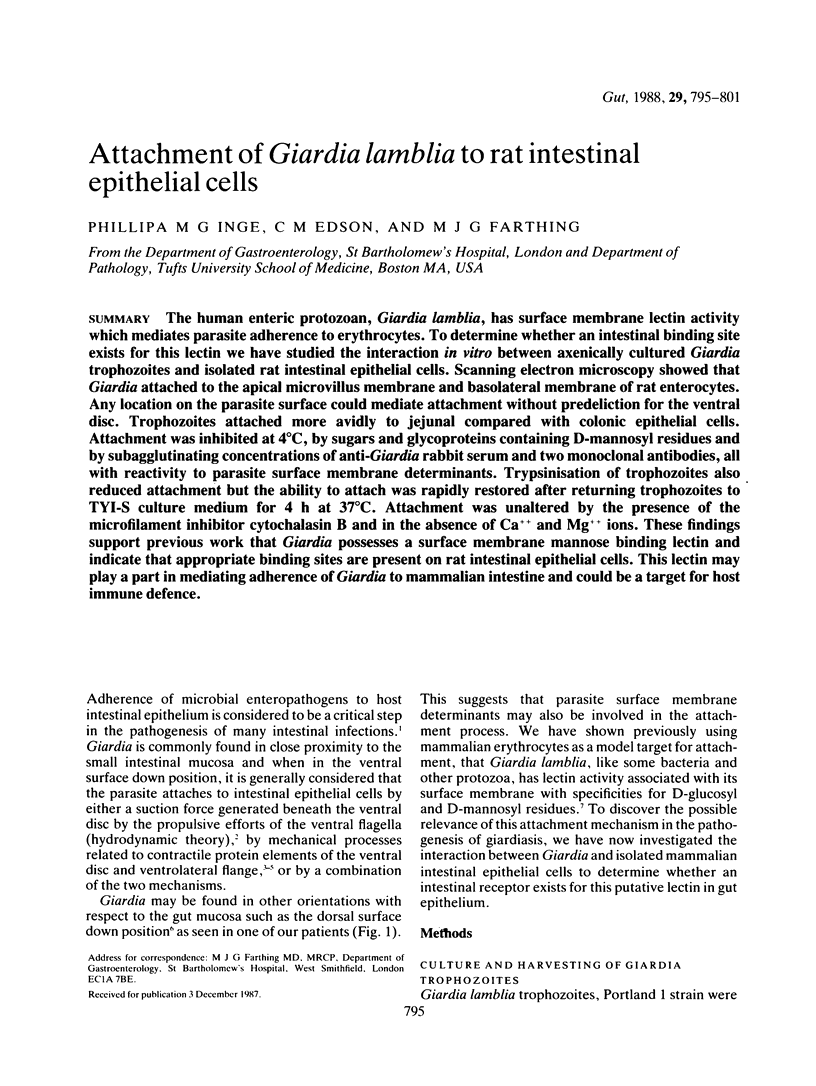

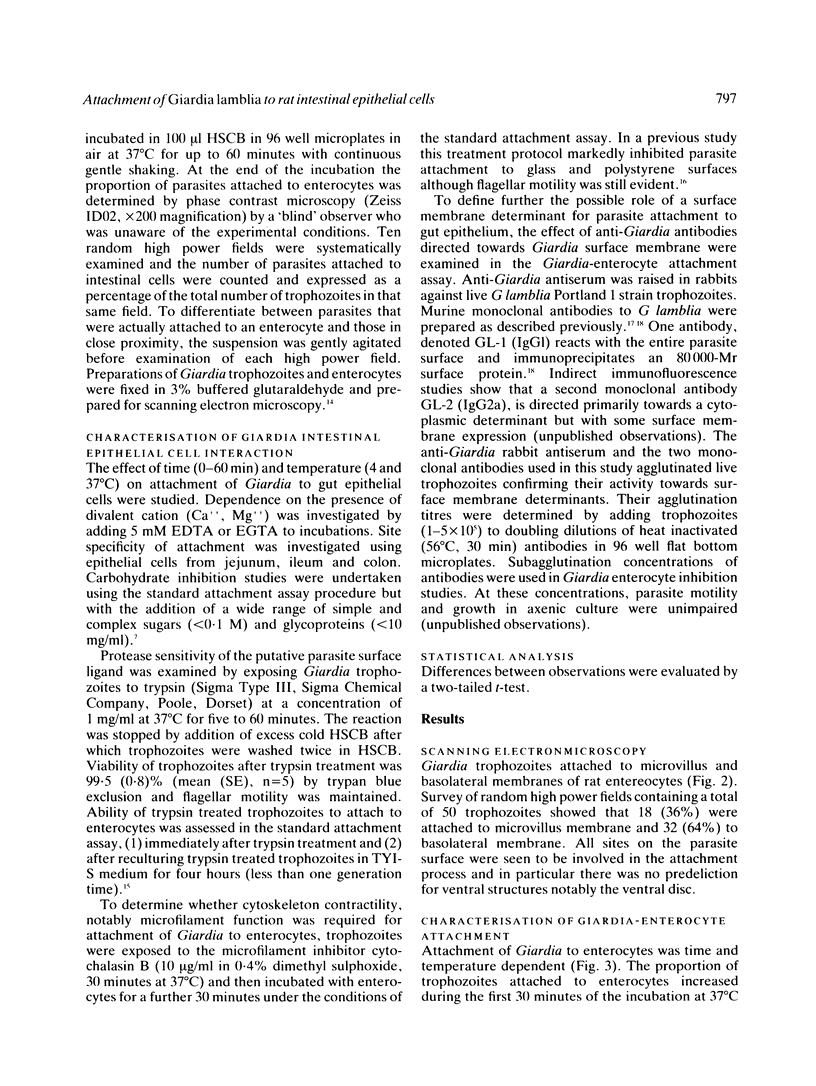
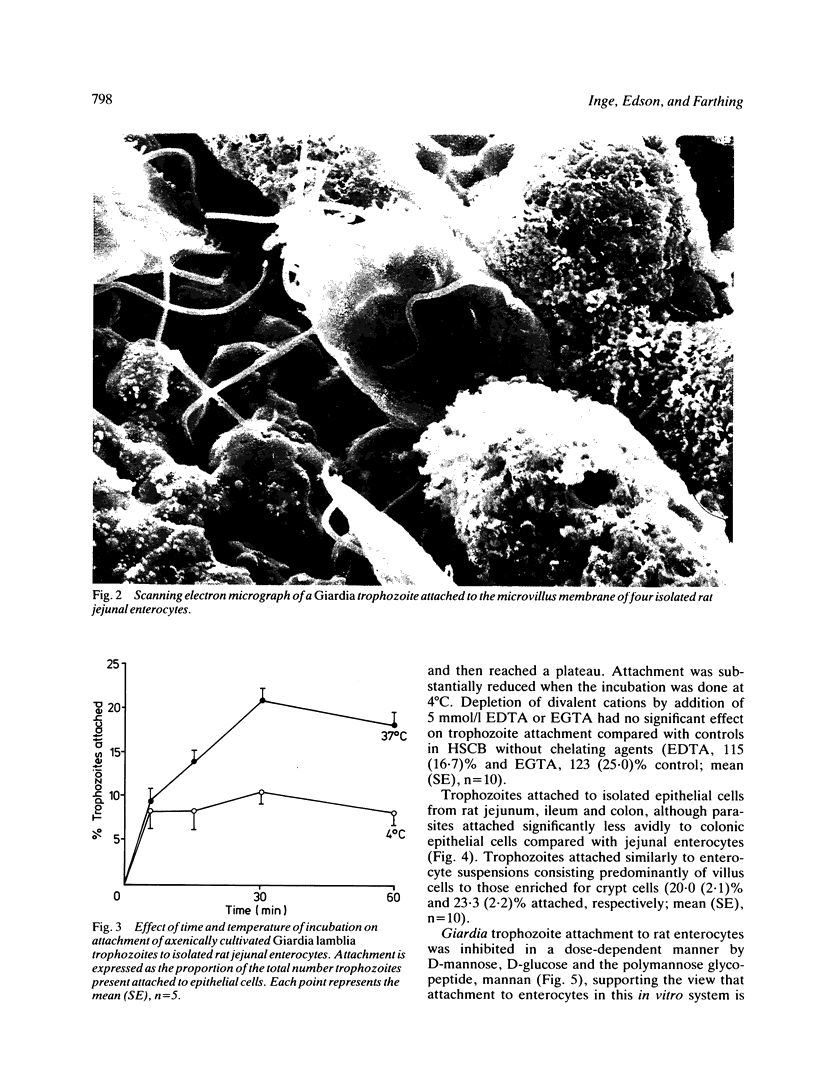

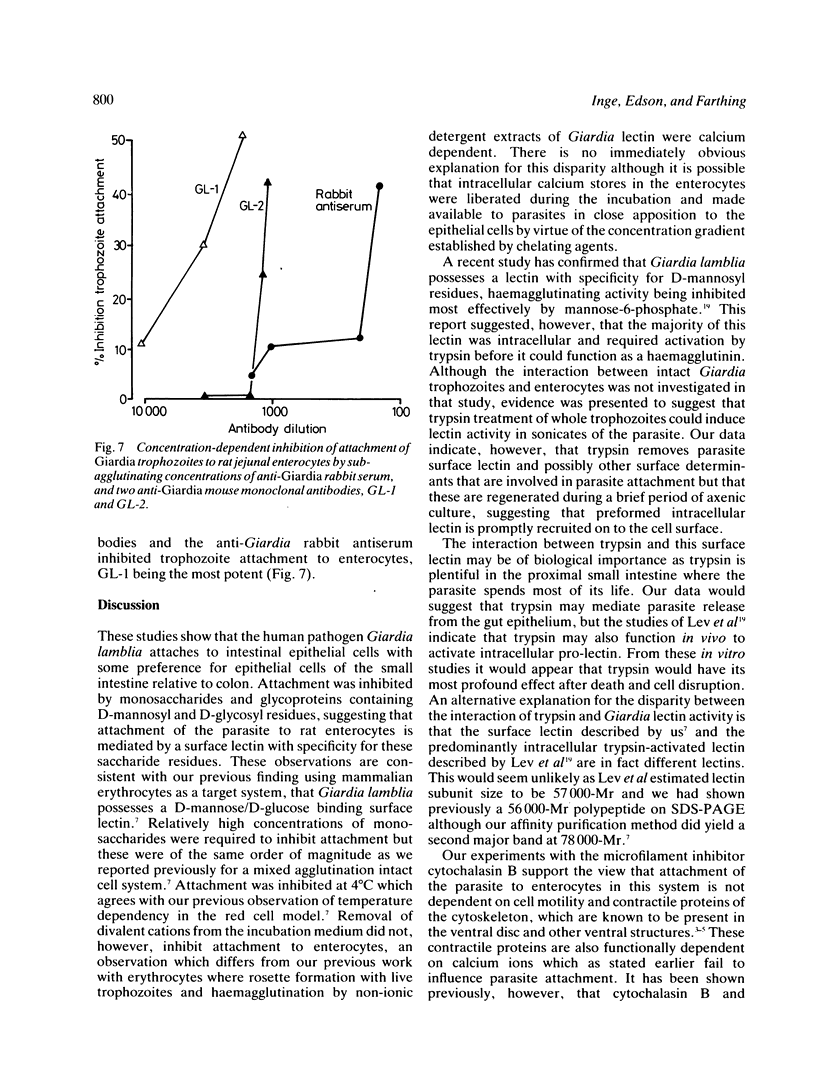
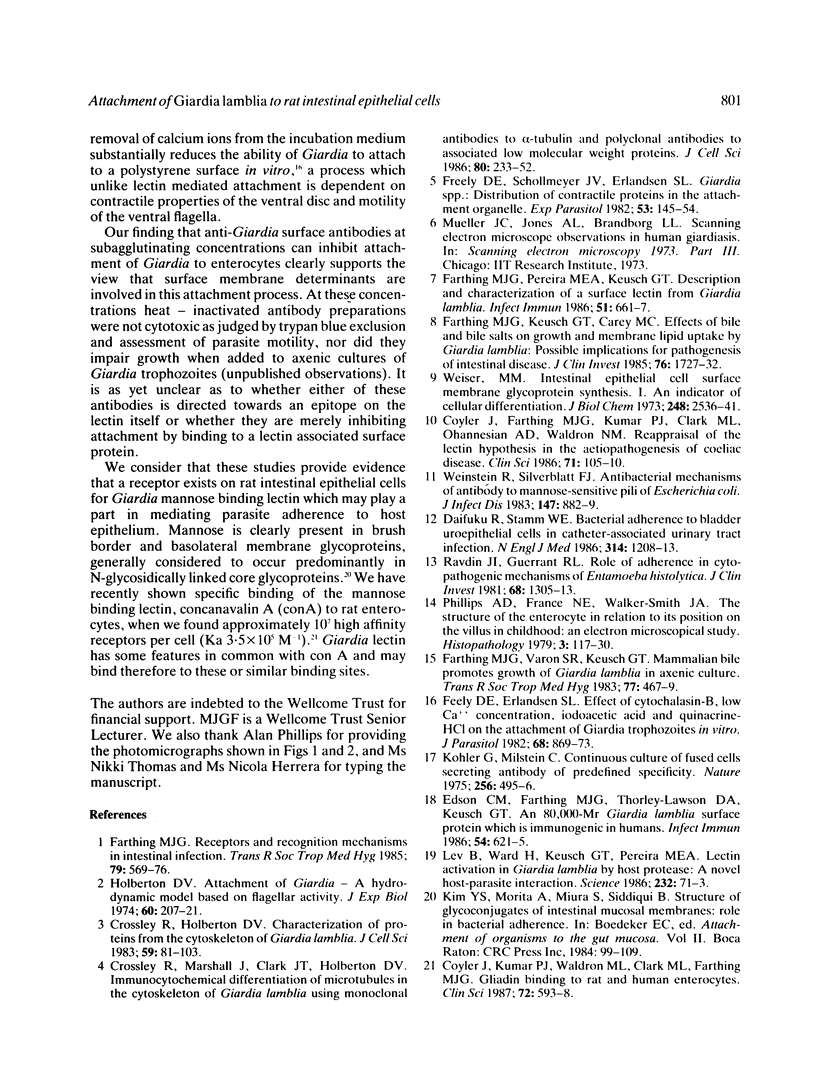
Images in this article
Selected References
These references are in PubMed. This may not be the complete list of references from this article.
- Colyer J., Farthing M. J., Kumar P. J., Clark M. L., Ohannesian A. D., Waldron N. M. Reappraisal of the 'lectin hypothesis' in the aetiopathogenesis of coeliac disease. Clin Sci (Lond) 1986 Jul;71(1):105–110. doi: 10.1042/cs0710105. [DOI] [PubMed] [Google Scholar]
- Colyer J., Kumar P. J., Waldron N. M., Clark M. L., Farthing M. J. Gliadin binding to rat and human enterocytes. Clin Sci (Lond) 1987 May;72(5):593–598. doi: 10.1042/cs0720593. [DOI] [PubMed] [Google Scholar]
- Crossley R., Holberton D. V. Characterization of proteins from the cytoskeleton of Giardia lamblia. J Cell Sci. 1983 Jan;59:81–103. doi: 10.1242/jcs.59.1.81. [DOI] [PubMed] [Google Scholar]
- Crossley R., Marshall J., Clark J. T., Holberton D. V. Immunocytochemical differentiation of microtubules in the cytoskeleton of Giardia lamblia using monoclonal antibodies to alpha-tubulin and polyclonal antibodies to associated low molecular weight proteins. J Cell Sci. 1986 Feb;80:233–252. doi: 10.1242/jcs.80.1.233. [DOI] [PubMed] [Google Scholar]
- Daifuku R., Stamm W. E. Bacterial adherence to bladder uroepithelial cells in catheter-associated urinary tract infection. N Engl J Med. 1986 May 8;314(19):1208–1213. doi: 10.1056/NEJM198605083141902. [DOI] [PubMed] [Google Scholar]
- Edson C. M., Farthing M. J., Thorley-Lawson D. A., Keusch G. T. An 88,000-Mr Giardia lamblia surface protein which is immunogenic in humans. Infect Immun. 1986 Dec;54(3):621–625. doi: 10.1128/iai.54.3.621-625.1986. [DOI] [PMC free article] [PubMed] [Google Scholar]
- Farthing M. J., Keusch G. T., Carey M. C. Effects of bile and bile salts on growth and membrane lipid uptake by Giardia lamblia. Possible implications for pathogenesis of intestinal disease. J Clin Invest. 1985 Nov;76(5):1727–1732. doi: 10.1172/JCI112162. [DOI] [PMC free article] [PubMed] [Google Scholar]
- Farthing M. J., Pereira M. E., Keusch G. T. Description and characterization of a surface lectin from Giardia lamblia. Infect Immun. 1986 Feb;51(2):661–667. doi: 10.1128/iai.51.2.661-667.1986. [DOI] [PMC free article] [PubMed] [Google Scholar]
- Farthing M. J. Receptors and recognition mechanisms in intestinal infection. Trans R Soc Trop Med Hyg. 1985;79(5):569–576. doi: 10.1016/0035-9203(85)90160-9. [DOI] [PubMed] [Google Scholar]
- Farthing M. J., Varon S. R., Keusch G. T. Mammalian bile promotes growth of Giardia lamblia in axenic culture. Trans R Soc Trop Med Hyg. 1983;77(4):467–469. doi: 10.1016/0035-9203(83)90115-3. [DOI] [PubMed] [Google Scholar]
- Feely D. E., Erlandsen S. L. Effect of cytochalasin-B, low Ca++ concentration, iodoacetic acid, and quinacrine-HCl on the attachment of Giardia trophozoites in vitro. J Parasitol. 1982 Oct;68(5):869–873. [PubMed] [Google Scholar]
- Feely D. E., Schollmeyer J. V., Erlandsen S. L. Giardia spp.: distribution of contractile proteins in the attachment organelle. Exp Parasitol. 1982 Feb;53(1):145–154. doi: 10.1016/0014-4894(82)90100-x. [DOI] [PubMed] [Google Scholar]
- Holberton D. V. Attachment of Giardia-a hydrodynamic model based on flagellar activity. J Exp Biol. 1974 Feb;60(1):207–221. doi: 10.1242/jeb.60.1.207. [DOI] [PubMed] [Google Scholar]
- Köhler G., Milstein C. Continuous cultures of fused cells secreting antibody of predefined specificity. Nature. 1975 Aug 7;256(5517):495–497. doi: 10.1038/256495a0. [DOI] [PubMed] [Google Scholar]
- Lev B., Ward H., Keusch G. T., Pereira M. E. Lectin activation in Giardia lamblia by host protease: a novel host-parasite interaction. Science. 1986 Apr 4;232(4746):71–73. doi: 10.1126/science.3513312. [DOI] [PubMed] [Google Scholar]
- Phillips A. D., France N. E., Walker-Smith J. A. The structure of the enterocyte in relation to its position on the villus in childhood: an electron microscopical study. Histopathology. 1979 Mar;3(2):117–130. doi: 10.1111/j.1365-2559.1979.tb02988.x. [DOI] [PubMed] [Google Scholar]
- Ravdin J. I., Guerrant R. L. Role of adherence in cytopathogenic mechanisms of Entamoeba histolytica. Study with mammalian tissue culture cells and human erythrocytes. J Clin Invest. 1981 Nov;68(5):1305–1313. doi: 10.1172/JCI110377. [DOI] [PMC free article] [PubMed] [Google Scholar]
- Weinstein R., Silverblatt F. J. Antibacterial mechanisms of antibody to mannose-sensitive pili of Escherichia coli. J Infect Dis. 1983 May;147(5):882–889. doi: 10.1093/infdis/147.5.882. [DOI] [PubMed] [Google Scholar]
- Weiser M. M. Intestinal epithelial cell surface membrane glycoprotein synthesis. I. An indicator of cellular differentiation. J Biol Chem. 1973 Apr 10;248(7):2536–2541. [PubMed] [Google Scholar]



